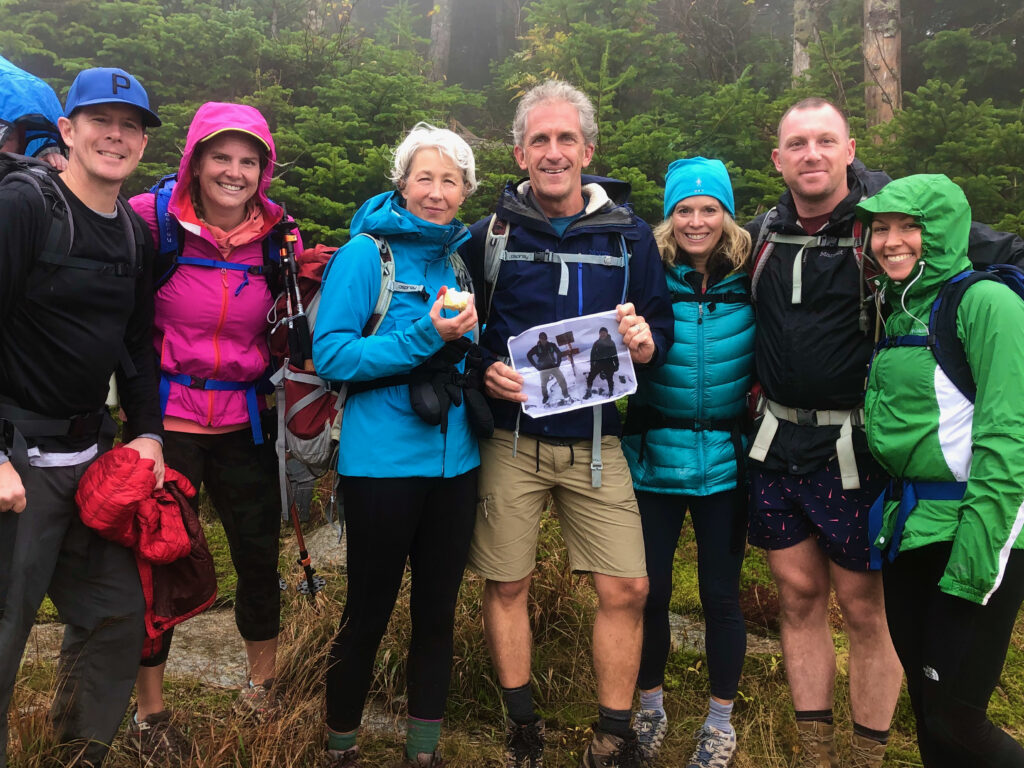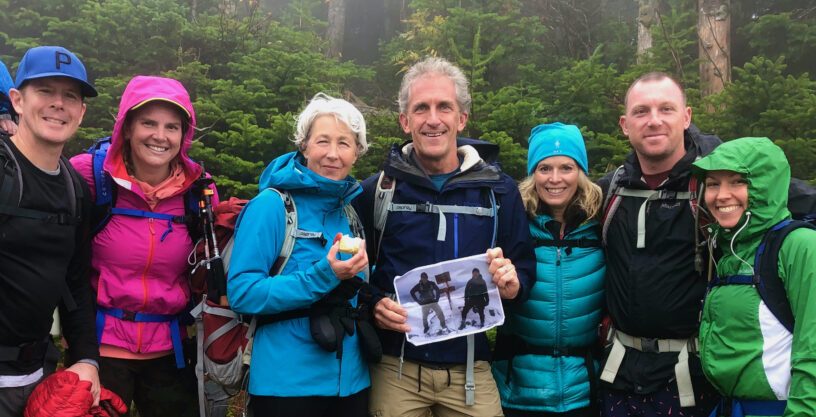One minute I was navigating a particularly tricky and deeply snow-covered trail on the downward slope of the Carter Notch, halfway through a planned weekend traverse of the six Wildcat and Carter Mountain range peaks; and the next, somehow, I was flat on my belly sliding backward through the trees and underbrush, one leg pinned behind me by a snowshoe caught on my pack, trekking poles strapped to my wrists and flailing in every direction, wondering what the landing was going to feel like.
My hiking companion and brother, Mitch Riley, was howling with laughter.
It was not my proudest moment in the mountains, but I survived with only a few bruises and another story to tell.
The AMC 4,000-Footer Club
There are 48 peaks in New Hampshire’s White Mountain National Forest that are at least 4,000 feet tall, spread out across seven mountain ranges covering over a third of the state.
For hiking enthusiasts like me, the Appalachian Mountain Club offers membership in the “AMC Four Thousand-Footer Club” to anyone who hikes to the top of every one of them.
There are hikers who reach the peaks of the 48 4,000-footers in a single year, or whose ambitions drive them to hike all 48 mountains in each month of the year (yes, that’s 48 X 12 = 576 summits), a feat known as “The Grid.”
Each mountain has one or more reasonably well-marked trails, and most of the summits can be reached in a few hours of steady hiking beneath beautiful canopies of trees, over piles of New England stones and boulders, across creeks or rivers and, on the highest summits above tree line, through alpine-arctic tundra that seems like the surface of another planet.
Some of the mountains are also close enough together that reasonably fit and swift-moving hikers can summit two or even three in a day, a feat known as “peak bagging.”
And, for those who like to combine hiking with some extra time camping up in the mountains, there are tended “huts” and plenty of sites to pitch a tent during multi-day “traverses” of several mountains at a time.
Not Without Peril
A 4,000-foot mountain is small by big mountain standards.
Denver, Colorado is called the “Mile High City” because its elevation is exactly 5,280 feet. The North American Rocky Mountains, including several peaks in Colorado, reach heights of over 14,000 feet.
Mount Kilimanjaro, the tallest peak in Africa and the highest freestanding mountain in the world, is just over 19,000 feet. I climbed there in January 2020 and shared my experience in “Jambo! Climbing Lessons for Community College Students from the Summit of Mt. Kilimanjaro.”
And, of course, Mount Everest, Earth’s highest mountain above sea level, stands at more than 29,000 feet.
But although New Hampshire’s 48 4,000-footers may be only a fraction of the globe’s most sizable summits, they can be quite formidable.
Mount Washington, the tallest of the bunch, standing at 6,288 feet, is famously known as the “Home of the World’s Worst Weather.”
Indeed, in 1934 the Mount Washington Observatory recorded a world record wind speed of 231 mph at the summit; and a record low temperature of -47 degrees Fahrenheit. In the wintertime, it is not unusual for Mount Washington to have the lowest temperature on Earth; lower than Antarctica and lower, even, as the Boston Globe reported in 2017, than the planet Mars.
In Not Without Peril: 150 Years of Misadventure on the Presidential Range of New Hampshire (a book with an ominous sounding title that my daughters gave me for Father’s Day a few years ago), journalist and outdoorsman Nicholas Howe chronicles more than a century of wicked winter storms, frostbite, hypothermia, and, far more than you might expect, death up in those White Mountains.
Mount Washington by itself has been responsible for over 160 deaths since 1849, earning it the distinction of having more fatalities per vertical foot than any other mountain in the world.
Why?
Today, I completed my 48th 4,000-footer when I summited Cannon Mountain, part of the Kinsman Range in Franconia State Park, about ten years after I started hiking those magnificent mountains; and I look forward to the annual “Four Thousand-Footer Annual Club Meeting Dinner and Awards Night” next spring when I will take my place, alongside a few thousand others, in the ranks of New England’s most avid hikers.
My approach to joining the club has always been a bit casual. Rather than trying to tag all those peaks in a year, or in each month, or in some other highly organized, time-driven way, I’ve just looked for any opportunity I could find to drive north and hit the trails.
Why?
I’ve always enjoyed the outdoors.
When I was born, I lived with a foster family for a couple of years. My foster mother kept a journal about me which went along with me when I was adopted.
When I was a year old and living in Worcester, Massachusetts she wrote in her journal, “Adam (my foster family called me by my middle name) is an outdoors boy. We spent a week camping way up in the woods of Maine where he was outside all day every day, and now outside is where he wants to be all the time.”
Wherever I have lived or traveled after that—Oklahoma, California, Michigan, Canada, Europe, Australia, Asia, the Middle East—I have always looked for ways to get out and adventure, whether up mountains, across lakes or oceans, or through deserts, I love moving around out in the world.
There is a wonderful combination of physical exertion and a sense of awe at the beauty of nature that you can only get when you immerse yourself in it.
I used to have a dog, an Airedale terrier named Sparty, who was very active (like me). From time to time when I was traveling and needed to board him, I would take him to a place called the “Hydrant Regency” where they had a sign on the wall in the lobby that read: “A tired dog is a good dog.”
That became a mantra around my house. My wife, kids, and anyone who knows me well knows that I need exercise every day to be a “good dog.” It relaxes me, helps me to focus, and keeps me friendly.
Then there is the magnificence of the trees, a form of physiological and psychological exercise the Japanese call “shinrin-yoku” or “forest bathing.”
A few weeks ago, Boston’s NPR station WBUR aired a special report, “Trees: Our Mental, Physical, Climate Change Antidote” that explored, among other things, the growing body of research making connections between trees and our individual and collective health, including “everything from better birth outcomes to fewer symptoms of ADHD, lower risk of heart disease and diabetes, less stress, anxiety and depression — even a longer life.”
So, there’s that.
But most of all, I decided to hike to the top of those 48 mountains because of my friend, Patrick.
Patrick was my next-door neighbor, who became my best friend. He introduced me to the White Mountains not long after I moved back to Massachusetts when he invited me to roam up Mount Mousilauke, the westernmost mountain among the 48 4,000-footers, with he and his wife, Susan.
From the moment we set foot on the Gorge Brook Trail, just behind Dartmouth College’s Mousilauke Ravine Lodge, I was hooked.
Since that day, I’ve covered hundreds of miles of trails across the White Mountains in every season of the year (winter hiking is actually my favorite); summiting several peaks, including Mount Mousilauke and Mount Washington, more than once, and introducing lots of family members and friends to my outdoors obsession.
My wife, Margaret, and I met while running in 2012, and our first couple of dates were hikes up Mount Monadnock and along the Franconia Ridge with Patrick and Susan.
I remember those hikes with the four of us as some of our happiest times on the trails.
Patrick was a born naturalist who loved tending his flower gardens and bevy of bird feeders at home, and naming all the flora and fauna we would find while out roaming the trails together.
In 2014, we were on our way back from a hike when Patrick suddenly became wretchedly ill.
Not long afterward, he was diagnosed with stage four glioblastoma, an aggressive brain cancer with a life expectancy of 12-18 months.
Just over a year later, after surgery, radiation, and debilitating chemotherapy treatments, Patrick, my friend and constant companion up in the mountains, died.
It was only then that I decided to actually figure out how many of the 48 4,000-footers I had hiked with Patrick, and hike the rest of them in his memory.
My brother, Mitch Riley, was an Army officer in Afghanistan, then stationed for a time in Hawaii, while Patrick and I were up hiking around the Whites.
By 2015, he had left the Army, completed his MBA, and returned home to live and work in the Boston area. Like me, he loves the outdoors, and started hiking his 48 along with me.
Mitch and I finished our list together today, alongside Margaret, Susan, and a handful of close friends and family (a few of whom took advantage of the gondola on Mount Cannon to get a quick ride to the top for the beautiful views of the New England autumn leaves blanketing the White Mountain National Forest.)

This one, and all the ones before it, are for you, Patrick.
Hiking New Hampshire’s 48 4,000-Footers: A Gallery
There are lots of memorable moments from a decade or so on the trails of New Hampshire’s 48 4,000-footers. Here is a gallery of some of my favorites:






